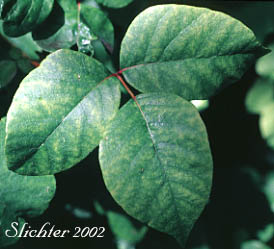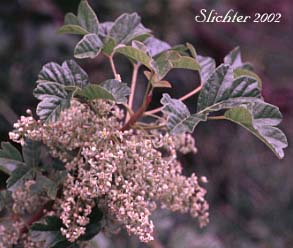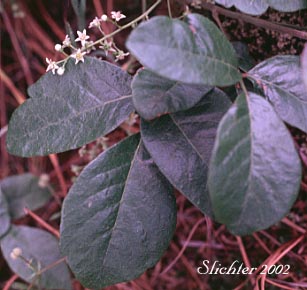

 The
photo at right shows Rhus diversiloba in flower from Catherine Creek,
Columbia River Gorge..........May 13, 2000.
The
photo at right shows Rhus diversiloba in flower from Catherine Creek,
Columbia River Gorge..........May 13, 2000.Poison oak is a problematic shrub or climbing vine from 1-15 meters high. The herbage ranges from glabrous to pubescent, and all parts of the plant contain a volatile oil which causes a severe dermatitis (rash) on many humans. The leaves are trilobate, the individual leaves ovate to obovate in shape with wavy to fairly deeply lobed margins. They range from 3-7 cm long and have rounded to shortly acute tips. Leaf surfaces are commonly a shiny green, while new foliage is commonly a deep burgundy red.
The inflorescence consists of loose, axillary panicles. The whitish flowers are either male or female. They range from 1-2 mm long and have 5 petals and 5 sepals (which are about half the length of the petals and pubescent to glabrous). The glabrous fruits are globose, whitish to greenish-white and about 5 mm long.
As described above, all parts of this plant contain dermatitis-causing oils. Exposure to any part of the plant is thus to be discouraged. No part of the plant should be eaten, and one should avoid its smoke when the plant is burned. Poison oak is a major annoyance to hikers, fishermen and hunters, beach-goers, land owners and fighters of forest fires.
Along the coast, poison oak may be found in the open or in scrub areas, or as part of the forest understory in areas behind the beaches. In drier inland areas, it is common at low elevation in valley or canyon bottoms.
 The
photo at right shows a young, bright reddish leaf of Toxicodendron diversilobum.
Remember the adage: "Shiny leaves of three, let it be!" Photo taken
at Cathernine Creek, Columbia River Gorge.........April 16, 2000.
The
photo at right shows a young, bright reddish leaf of Toxicodendron diversilobum.
Remember the adage: "Shiny leaves of three, let it be!" Photo taken
at Cathernine Creek, Columbia River Gorge.........April 16, 2000.
Toxicodendron diversilobum is found primarily west of the Cascade and Sierra Nevada crests from southwestern British Columbia south through the Puget Trough to northern Baja California. It extends eastward through the Columbia River Gorge to Klickitat County in Washington, and may also be found in the Virginia Mts. to the west of Pyramid Lake in Nevada. In western Oregon, it is largely coastal, although it extends in land to the Cascades in the Siskiyou Mts. of southwestern Oregon.
In the Columbia River Gorge it may be found between the elevations of 100'-1800' from the mouth of the Sandy River east towards The Dalles, OR. Poison oak may on a casual glance be confused with Oregon white oak, which is often found in the same locality. The latter tree has simple, pinnately lobed leaves.
